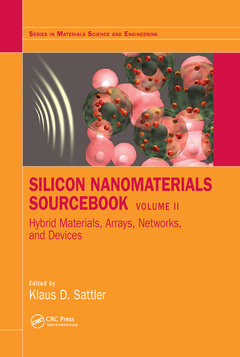Silicon Nanomaterials Sourcebook Hybrid Materials, Arrays, Networks, and Devices, Volume Two Series in Materials Science and Engineering Series
Coordonnateur : Sattler Klaus D.

This comprehensive tutorial guide to silicon nanomaterials spans from fundamental properties, growth mechanisms, and processing of nanosilicon to electronic device, energy conversion and storage, biomedical, and environmental applications. It also presents core knowledge with basic mathematical equations, tables, and graphs in order to provide the reader with the tools necessary to understand the latest technology developments.
From low-dimensional structures, quantum dots, and nanowires to hybrid materials, arrays, networks, and biomedical applications, this Sourcebook is a complete resource for anyone working with this materials:
- Covers fundamental concepts, properties, methods, and practical applications.
- Focuses on one important type of silicon nanomaterial in every chapter.
- Discusses formation, properties, and applications for each material.
- Written in a tutorial style with basic equations and fundamentals included in an extended introduction.
- Highlights materials that show exceptional properties as well as strong prospects for future applications.
Klaus D. Sattler is professor physics at the University of Hawaii, Honolulu, having earned his PhD at the Swiss Federal Institute of Technology (ETH) in Zurich. He was honored with the Walter Schottky Prize from the German Physical Society, and is the editor of the sister work also published by Taylor & Francis, Carbon Nanomaterials Sourcebook, as well as the acclaimed multi-volume Handbook of Nanophysics.
I. Arrays, Hybrids, Core-Shell Formation and optical properties of silicon nanowire arrays. Inverted Silicon Nanopencil Arrays. Single Crystal Silicon Nanopore and Arrays. 3D Si Quantum Dot Array. Systems of Silicon Nanocrystals and their Peculiarities. Silicon/Polymer Composite Nanopost Arrays. Vertical Silicon Nanostructures. Silicon Nanowire and Nanohole Arrays. Silicon-Based Core-Shell Nanostructures. II. Functional Materials. Porous Silicon as Template for Magnetic Nanostructures. Heat and Mass Transfer in Silicon-Based Nanostructures. Electrodeposited Silicon from Ionic Liquids. Sonosensitizing Properties of Silicon Nanoparticles. Silicon Metamaterials with Exotic Mid-Infrared Radiative Properties. Antireflective Silicon Nanostructures. Black Silicon Antireflection Nanostructures. Silicon Nanowires in Biomedicine. Silicon Dots in Radiotherapy. III. Industrial Nanosilicon. Silicon-based Anode Materials for Lithium Ion Batteries. Silicon Nanopowders from Plasma for Li-ion Batteries. Nanophotonics Silicon Solar Cells. Photovoltaic Structures Based on Porous Silicon. Silicon Nano-Stalagmite for Hybrid Solar Cells. Bottom-up Nanostructured Silicon for Thermoelectrics. Nanosilicon and Thermoelectricity. Nanostructured Silicon for Thermoelectrics. Nanoscale Silicon in Photonics and Photovoltaics. Silicon/Carbon Yolk-Like Nanostructure for Energy Storage. Nanosilicon for Quantum Information.
Klaus D. Sattler pursued his undergraduate and master’s courses at the University of Karlsruhe in Germany. He received his PhD under the guidance of Professors G. Busch and H.C. Siegmann at the Swiss Federal Institute of Technology (ETH) in Zurich, where he was among the first to study spin-polarized photoelectron emission. In 1976, he began a group for atomic cluster research at the University of Konstanz in Germany, where he built the first source for atomic clusters and led his team to pioneering discoveries such as "magic numbers" and "Coulomb explosion." He was at the University of California, Berkeley, for three years as a Heisenberg fellow, where he initiated the first studies of atomic clusters on surfaces with a scanning tunneling microscope.
Dr. Sattler accepted a position as professor of physics at the University of Hawaii, Honolulu, in 1988. There, he initiated a research group for nanophysics, which, using scanning probe microscopy, obtained the first atomic-scale images of carbon nanotubes directly confirming the graphene network. In 1994, his group produced the first carbon nanocones. He has also studied the formation of polycyclic aromatic hydrocarbons (PAH) and nanoparticles in hydrocarbon flames in collaboration with ETH Zurich. Other research has involved the nanopatterning of nanoparticle films, charge density waves on rotated graphene sheets, band gap studies of quantum dots, and graphene folds. His current work focuses on novel nanomaterials and solar photocatalysis with nanoparticles for the purification of water.
He is the editor of the sister reference, Carbon Nanomaterials Sourcebook (CRC Press, 2016), Fundamentals of Picoscience (CRC Press, 2014), and the seven-volume Handbook of Nanophysics (CRC Press, 2011). Among his many other accomplishments, Dr. Sattler was awarded the prestigious Walter Schottky Prize from the German Physical Society in 1983. At the University of Ha
Date de parution : 03-2021
17.8x25.4 cm
Date de parution : 08-2017
17.8x25.4 cm
Thèmes de Silicon Nanomaterials Sourcebook :
Mots-clés :
Metal Assisted Chemical Etching; Silicon Nanowires; silicon nanomaterials; Silicon Nanowires Arrays; silicene; Si Nanowires; nanosilicon; Si Nanocrystals; Anna S; Kalyuzhnaya; Solar Cells; Aleksandra I; Efimova; Porous Silicon; Leonid A; Golovan; American Chemical Society; Kirill A; Gonchar; Silicon Nanocrystals; Victor Y; Timoshenko; SEM Image; Fei Xiu; Nanohole Arrays; Johnny C; Ho; Silicon Nanoparticles; Zewen Liu; Si Core; Yifan Wang; Nanostructured Silicon; Seiji Samukawa; Seebeck Coefficient; Vladimir A; Terekhov; Etch Rate; Sergey Y; Turishchev; Quantum Dots; Evelina P; Domashevskaya; Photonic Crystal; Xueyao Liu; Copyright Wiley VCH Verlag GmbH; Wendong Liu; Porous Silicon Layer; Bai Yang; Light Trapping Effect; Seyeong Lee; Anisotropic Wet Etching; Dong-Hee Kang; Si Nanoparticles; Seong-Min Kim; NC Array; Myung-Han Yoon; Silicon Nanopowders; Changying Zhao; Xing Fang; Mallar Ray; Sayak Dutta Gupta; Atrayee Hazra; Petra Granitzer; Klemens Rumpf; Hyung Hee Cho; Beom Seok Kim; Frank Endres; Liubov A; Osminkina; Andrew P; Sviridov; Xianglei Liu; Zhuomin M; Zhang; Young J; Yoo; Eun K; Kang; Yong T; Lee; Young M; Song; Martin Steglich; Oliver Puffky; Alp Özgün; Bora Garipcan; María L; Dell´Arciprete; Mnica C; Gonzalez; Roxana M; Gorojod; Mnica L; Kotler; Gyeong S; Hwang; Chia-Yun Chou; Dominic Leblanc; Richard Dolbec; Abdelbast Guerfi; Jiayin Guo; Pierre Hovington; Maher Boulos; Karim Zaghib; Boyuan Cai; Baohua Jia; Igor B; Olenych; Liubomyr S; Monastyrskii; Olena I; Aksimentyeva; Zingway Pei; Subramani Thiyagu; Aikebaier Yusufu; Ken Kurosaki; Dario Narducci; Giovanni Pennelli; Elisabetta Dimaggio; Fabio Iacona; Alessia Irrera; Salvatore Mirabella; Simona Boninelli; Barbara Fazio; Maria Miritello; Antonio Terrasi; Giorgia Franzò; Francesco Priolo; Xuefeng Song; Zhuang Sun; Cheng Yang; Lisong Xiao; Davide Rotta; Enrico Prati



